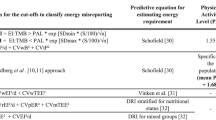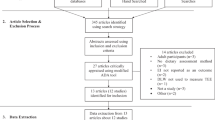Abstract
Background/Objectives:
Comparing reported energy intakes with estimated energy requirements as multiples of basal metabolic rate (Ein:BMR) is an established method of identifying implausible food intake records. The present study aimed to examine the validity of self-reported food intakes believed to be plausible.
Subjects/Methods:
One hundred and eighty men and women were provided with all food and beverages for two consecutive days in a residential laboratory setting. Subjects self-reported their food and beverage intakes using the weighed food diary method (WDR). Investigators covertly measured subjects’ actual consumption over the same period. Subjects also reported intakes over four consecutive days at home. BMR was measured by indirect calorimetry.
Results:
Average reported energy intakes were significantly lower than actual intakes (11.2 and 11.8 MJ/d, respectively, P<0.001). Two-thirds (121) of the WDR were under-reported to varying degrees. Only five of these were considered as implausible using an Ein:BMR cut-off value of 1.03*BMR. Under-reporting of food and beverage intakes, as measured by the difference between reported and actual intake, was evident at all levels of Ein;BMR. Reported energy intakes were lower still (10.2 MJ/d) while subjects were at home.
Conclusions:
Under-recording of self-reported food intake records was extensive but very few under-reported food intake records were identified as implausible using energy intake to BMR ratios. Under-recording was evident at all levels of energy intake.
This is a preview of subscription content, access via your institution
Access options
Subscribe to this journal
Receive 12 print issues and online access
$259.00 per year
only $21.58 per issue
Buy this article
- Purchase on Springer Link
- Instant access to full article PDF
Prices may be subject to local taxes which are calculated during checkout



Similar content being viewed by others
References
Black AE, Cole TJ . Within- and between-subject variation in energy expenditure measured by the doubly-labelled water technique: implications for validating reported dietary energy intake. Eur J Clin Nutr 2000; 54: 386–394.
Black AE, Prentice AM, Goldberg GR, Jebb SA, Bingham SA, Livingstone MB et al. Measurements of total energy expenditure provide insights into the validity of dietary measurements of energy intake. J Am Diet Assoc 1993; 93: 572–579.
Livingstone MBE, Black AE . Markers of the validity of reported energy intake. J Nutr 2003; 133: 895S–920S.
Archer E, Hand GA, Blair SN . Validity of U.S. Nutritional Surveillance: National Health and Nutrition Examination Survey Caloric Energy Intake Data, 1971–2010. PLoS One 2013; 8: e76632.
Rennie KL, Coward A, Jebb SA . Estimating under-reporting of energy intake in dietary surveys using an individualised method. Br J Nutr 2007; 97: 1169–1176.
Macdiarmid J, Blundell J . Assessing dietary intake: Who, what and why of under-reporting. Nutr Res Rev 1998; 11: 231–253.
Stubbs RJ, O’Reilly LM, Whybrow S, Fuller Z, Johnstone AM, Livingstone BE et al. Measuring the difference between actual and reported food intake in the context of energy balance under laboratory conditions. Br J Nutr 2014; 111: 2032–2043.
Schebendach JE, Porter KJ, Wolper C, Walsh BT, Mayer LE . Accuracy of self-reported energy intake in weight-restored patients with anorexia nervosa compared with obese and normal weight individuals. Int J Eat Disord 2012; 45: 570–574.
Poppitt SD, Swann D, Black AE, Prentice AM . Assessment of selective under-reporting of food intake by both obese and non-obese women in a metabolic facility. Int J Obes 1998; 22: 303–311.
Poslusna K, Ruprich J, de Vries JH, Jakubikova M, van't Veer P . Misreporting of energy and micronutrient intake estimated by food records and 24 hour recalls, control and adjustment methods in practice. Br J Nutr 2009; 101: S73–S85.
Goldberg GR, Black AE, Jebb SA, Cole TJ, Murgatroyd PR, Coward WA et al. Critical-evaluation of energy-intake data using fundamental principles of energy physiology.1. Derivation of cutoff limits to identify under-recording. Eur J Clin Nutr 1991; 45: 569–581.
Horgan G, Stubbs JR . Predicting basal metabolic rate in the obese is difficult. Eur J Clin Nutr 2003; 57: 335–340.
Black AE . Critical evaluation of energy intake using the Goldberg cut-off for energy intake: basal metabolic rate. A practical guide to its calculation, use and limitations. Int J Obes 2000; 24: 1119–1130.
Whybrow S, Mayer C, Kirk TR, Mazlan N, Stubbs RJ . Effects of two-weeks' mandatory snack consumption on energy intake and energy balance. Obes Res 2007; 15: 673–685.
Goris AHC, Meijer EP, Westerterp KR . Repeated measurement of habitual food intake increases under-reporting and induces selective under-reporting. Br J Nutr 2001; 85: 629–634.
Milne AC, McNeill G, Zakary A . Weight change as an indicator of energy imbalance during 7 day weighed food intake studies. Ecol Food Nutr 1991; 26: 281–289.
Bingham SA, Cummings JH . Urine nitrogen as an independent validatory measure of dietary intake: a study of nitrogen balance in individuals consuming their normal diet. Am J Clin Nutr 1985; 42: 1276–1289.
Bingham SA . The dietary assessment of individuals; methods, accuracy, new techniques and recommendations. Nutr Abstr Rev 1987; 57: 705–742.
McCance and Widdowson’s Composition of Foods integrated dataset (CoF IDS) [database on the Internet]. Food Standards Agency. Crown copyright. 2002. Available from: http://www.food.gov.uk/science/dietarysurveys/dietsurveys/ Accessed 19 May 2010.
Elia M, Livesey G . Energy expenditure and fuel selection in biological systems: the theory and practice of calculations based on indirect calorimetry and tracer methods. World Rev Nutr Diet 1992; 70: 68–131.
Scientific Advisory Committee on Nutrition Energy Requirement Working Group Draft Report. London: SACN, 2009.
Myers RJ, Klesges RC, Eck LH, Hanson CL, Klem ML . Accuracy of self-reports of food intake in obese and normal-weight individuals: effects of obesity on self-reports of dietary intake in adult females. Am J Clin Nutr 1988; 48: 1248–1251.
Conway JM, Ingwersen LA, Vinyard BT, Moshfegh AJ . Effectiveness of the US Department of Agriculture 5-step multiple-pass method in assessing food intake in obese and nonobese women. Am J Clin Nutr 2003; 77: 1171–1178.
Schofield WN . Predicting basal metabolic rate, new standards and review of previous work. Hum Nutr Clin Nutr 1985; 39: 5–41.
Henry CJK . Basal metabolic rate studies in humans: measurement and development of new equations. Public Health Nutr 2005; 8: 1133–1152.
Gemming L, Jiang Y, Swinburn B, Utter J, Mhurchu CN . Under-reporting remains a key limitation of self-reported dietary intake: an analysis of the 2008/09 New Zealand Adult Nutrition Survey. Eur J Clin Nutr 2014; 68: 259–264.
Dhurandhar NV, Schoeller D, Brown AW, Heymsfield SB, Thomas D, Sorensen TIA et alEnergy Balance Measurement Working Group. Energy balance measurement: when something is not better than nothing. Int J Obes 2014; 39: 1109–1113.
Acknowledgements
The original study, from which the current data were taken, was funded by the Food Standards Agency, UK.
Author information
Authors and Affiliations
Corresponding author
Ethics declarations
Competing interests
The authors declare no conflict of interest.
Rights and permissions
About this article
Cite this article
Whybrow, S., Stubbs, R., Johnstone, A. et al. Plausible self-reported dietary intakes in a residential facility are not necessarily reliable. Eur J Clin Nutr 70, 130–135 (2016). https://doi.org/10.1038/ejcn.2015.124
Received:
Revised:
Accepted:
Published:
Issue Date:
DOI: https://doi.org/10.1038/ejcn.2015.124
This article is cited by
-
Activity energy expenditure is an independent predictor of energy intake in humans
International Journal of Obesity (2019)
-
Biological and psychological mediators of the relationships between fat mass, fat-free mass and energy intake
International Journal of Obesity (2019)
-
Statistical models for meal-level estimation of mass and energy intake using features derived from video observation and a chewing sensor
Scientific Reports (2019)



